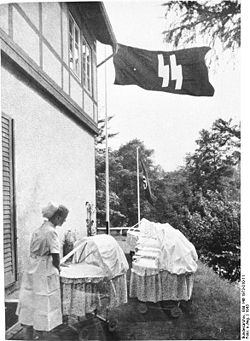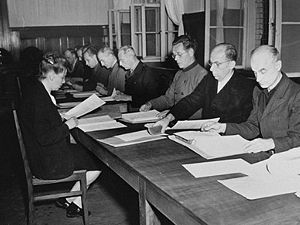
RuSHA
Encyclopedia
The Rasse- und Siedlungshauptamt-SS (SS Race and Settlement Main Office), (RuSHA), was the organization responsible for "safeguarding the racial 'purity' of the SS" within Nazi Germany
.
One of its duties was to oversee the marriages of SS personnel in accordance with the Aryan ideology
of the Nazi party. The RuSHA would only issue a permit to marry once detailed background investigations into the racial fitness of both prospective parents had been completed.
 The RuSHA was founded in 1931 by Reichsführer-SS
The RuSHA was founded in 1931 by Reichsführer-SS
Heinrich Himmler
and SS-Obergruppenführer
Richard Walther Darré as an SS office. Four years later it was upgraded to an SS Main Office in 1935. Under its first director, Darré, it propagated the Nazi ideology of "Blood and Soil". Darré was dismissed by Himmler in 1938 and was succeeded by SS-Gruppenführer
Günther Pancke
, SS-Gruppenführer
Otto Hofmann
in 1940, and SA
-Gruppenführer Richard Hildebrandt in 1943.
The RuSHA was created to monitor Himmler's 1931 order that the marital decisions of unmarried SS men should be supervised by the Nazi state
. SS men would thereafter have to apply for a marriage permit three months before getting married so that the parents of the fiancée could be investigated to ensure her racial purity. With time, the marriage laws became less strict, but RuSHA's power progressively grew in scope and other organizations came under its umbrella, such as the Ahnenerbe
.
In December 1935 Himmler ordered the RuSHA to establish the Lebensborn
network of maternity homes, whose purpose was "to accommodate and look after racially and genetically valuable expectant mothers."
In 1940 it was reorganized to create four main departments:
The Race and Settlement Departments were further divided into the Hauptabteilungen (Main Branches). One of these managed welfare and pensions in cooperation with the SS-Hauptfürsorge- und- Versorgungsamt (SS Main Welfare and Pension Department) at the Reich Ministry of the Interior
.

By 1937 more than 300 SS men had been expelled from the Schutzstaffel
for contravening Nazi race laws, although an order later stated that they could remain if they were already married and could satisfy racial criteria. In November 1940, Himmler reinstated all SS personnel expelled under the marriage laws, provided they met racial requirements of the NSDAP.
Following the invasion of the Soviet Union
in 1941, the RuSHA worked in partnership with VOMI in the "germanization" of captured territory, monitoring of settler welfare, and the plantation
of ethnic Germans
in areas designated for settlement by the SS, particularly in occupied Ukraine.
The RuSHA was also an advisory and executive office for all questions of racial selection. Racial examinations were performed by Rasse und Siedlungs (RUS) leaders or their racial examiners () in connection with:
The RuSHA also employed Josef Mengele
for a short time from November 1940 to early 1941, in Department II of its Family Office, where he was responsible for "care of genetic health" and "genetic health tests".
and tried by the Allied powers
at Nuremberg
. All were charged with crimes against humanity, war crimes and membership of a criminal organization (the SS). All but one (who was acquitted on the two more serious charges) were found guilty and sentenced to between three and 25 years imprisonment.
Nazi Germany
Nazi Germany , also known as the Third Reich , but officially called German Reich from 1933 to 1943 and Greater German Reich from 26 June 1943 onward, is the name commonly used to refer to the state of Germany from 1933 to 1945, when it was a totalitarian dictatorship ruled by...
.
One of its duties was to oversee the marriages of SS personnel in accordance with the Aryan ideology
Nazism and race
Nazism developed several theories concerning races. The Nazis claimed to scientifically measure a strict hierarchy of human race; at the top was the master race, the "Aryan race", narrowly defined by the Nazis as being identical with the Nordic race, followed by lesser races.At the bottom of this...
of the Nazi party. The RuSHA would only issue a permit to marry once detailed background investigations into the racial fitness of both prospective parents had been completed.
Formation

Reichsführer-SS
was a special SS rank that existed between the years of 1925 and 1945. Reichsführer-SS was a title from 1925 to 1933 and, after 1934, the highest rank of the German Schutzstaffel .-Definition:...
Heinrich Himmler
Heinrich Himmler
Heinrich Luitpold Himmler was Reichsführer of the SS, a military commander, and a leading member of the Nazi Party. As Chief of the German Police and the Minister of the Interior from 1943, Himmler oversaw all internal and external police and security forces, including the Gestapo...
and SS-Obergruppenführer
Obergruppenführer
Obergruppenführer was a Nazi Party paramilitary rank that was first created in 1932 as a rank of the SA and until 1942 it was the highest SS rank inferior only to Reichsführer-SS...
Richard Walther Darré as an SS office. Four years later it was upgraded to an SS Main Office in 1935. Under its first director, Darré, it propagated the Nazi ideology of "Blood and Soil". Darré was dismissed by Himmler in 1938 and was succeeded by SS-Gruppenführer
Gruppenführer
Gruppenführer was an early paramilitary rank of the Nazi Party, first created in 1925 as a senior rank of the SA.-SS rank:...
Günther Pancke
Günther Pancke
Günther Friedrich Wilhelm Ludwig Pancke was an SS-Obergruppenführer and the Higher SS and Police Leader of Denmark....
, SS-Gruppenführer
Gruppenführer
Gruppenführer was an early paramilitary rank of the Nazi Party, first created in 1925 as a senior rank of the SA.-SS rank:...
Otto Hofmann
Otto Hofmann
Otto Hofmann was an Austrian SS-Gruppenführer and an official of Nazi Germany's "Race and Settlement Main Office".-Early life:Hofmann was born in Innsbruck, Tyrol. He served as a military pilot in World War I...
in 1940, and SA
Sturmabteilung
The Sturmabteilung functioned as a paramilitary organization of the National Socialist German Workers' Party . It played a key role in Adolf Hitler's rise to power in the 1920s and 1930s...
-Gruppenführer Richard Hildebrandt in 1943.
The RuSHA was created to monitor Himmler's 1931 order that the marital decisions of unmarried SS men should be supervised by the Nazi state
Nazi Germany
Nazi Germany , also known as the Third Reich , but officially called German Reich from 1933 to 1943 and Greater German Reich from 26 June 1943 onward, is the name commonly used to refer to the state of Germany from 1933 to 1945, when it was a totalitarian dictatorship ruled by...
. SS men would thereafter have to apply for a marriage permit three months before getting married so that the parents of the fiancée could be investigated to ensure her racial purity. With time, the marriage laws became less strict, but RuSHA's power progressively grew in scope and other organizations came under its umbrella, such as the Ahnenerbe
Ahnenerbe
The Ahnenerbe was a Nazi German think tank that promoted itself as a "study society for Intellectual Ancient History." Founded on July 1, 1935, by Heinrich Himmler, Herman Wirth, and Richard Walther Darré, the Ahnenerbe's goal was to research the anthropological and cultural history of the Aryan...
.
In December 1935 Himmler ordered the RuSHA to establish the Lebensborn
Lebensborn
Lebensborn was a Nazi programme set up by SS leader Heinrich Himmler that provided maternity homes and financial assistance to the wives of SS members and to unmarried mothers, and also ran orphanages and relocation programmes for children.Initially set up in Germany in 1935, Lebensborn expanded...
network of maternity homes, whose purpose was "to accommodate and look after racially and genetically valuable expectant mothers."
Organization
In 1935 the RuSHA consisted of seven departments :- Amt Organisation und Verwaltungsamt (Organisation and Administration)
- Amt Rassenamt (Race)
- Amt Schulungsamt (Education)
- Amt Sippen und Heiratsamt (Family and Marriage)
- Amt Siedlungsamt (Settlement)
- Amt fur Archiv und Zeitungswesen (Records and Press)
- Amt fur Bevolkerungspolitik (Population Policy)
In 1940 it was reorganized to create four main departments:
- Amt Verwaltungsamt (Administration Office).
- Amt Rassenamt (Racial Office), it selected future SS personnel and conducted racial selections.
- Amt Heiratsamt (Marriage Office) it controlled the selection of suitable wives by SS men.
- Amt Siedlungsamt (Settlement Office), it dealt with the settlement of discharged SS men, especially in the annexed eastern areas.
The Race and Settlement Departments were further divided into the Hauptabteilungen (Main Branches). One of these managed welfare and pensions in cooperation with the SS-Hauptfürsorge- und- Versorgungsamt (SS Main Welfare and Pension Department) at the Reich Ministry of the Interior
Federal Ministry of the Interior (Germany)
The Federal Ministry of the Interior is a ministry of the German federal government. Its main office is in Berlin, with a secondary seat in Bonn. The current minister of the interior is Dr...
.
Racial policies

By 1937 more than 300 SS men had been expelled from the Schutzstaffel
Schutzstaffel
The Schutzstaffel |Sig runes]]) was a major paramilitary organization under Adolf Hitler and the Nazi Party. Built upon the Nazi ideology, the SS under Heinrich Himmler's command was responsible for many of the crimes against humanity during World War II...
for contravening Nazi race laws, although an order later stated that they could remain if they were already married and could satisfy racial criteria. In November 1940, Himmler reinstated all SS personnel expelled under the marriage laws, provided they met racial requirements of the NSDAP.
Following the invasion of the Soviet Union
Operation Barbarossa
Operation Barbarossa was the code name for Germany's invasion of the Soviet Union during World War II that began on 22 June 1941. Over 4.5 million troops of the Axis powers invaded the USSR along a front., the largest invasion in the history of warfare...
in 1941, the RuSHA worked in partnership with VOMI in the "germanization" of captured territory, monitoring of settler welfare, and the plantation
Plantation (settlement or colony)
Plantation was an early method of colonization in which settlers were "planted" abroad in order to establish a permanent or semi-permanent colonial base. Such plantations were also frequently intended to promote Western culture and Christianity among nearby indigenous peoples, as can be seen in the...
of ethnic Germans
Volksdeutsche
Volksdeutsche - "German in terms of people/folk" -, defined ethnically, is a historical term from the 20th century. The words volk and volkische conveyed in Nazi thinking the meanings of "folk" and "race" while adding the sense of superior civilization and blood...
in areas designated for settlement by the SS, particularly in occupied Ukraine.
The RuSHA was also an advisory and executive office for all questions of racial selection. Racial examinations were performed by Rasse und Siedlungs (RUS) leaders or their racial examiners () in connection with:
- Cases where sexual intercourse had occurred between Eastern European POWs or workers and Germans
- Children born to Eastern European workers
- Classification of people of German descent
- Selection of enemy nationals, particularly Poles and Slovakians, for slave labour and Germanization
- Kidnapping of children suitable for Germanization
- Population transfers
- The persecution and liquidation of Jews
The RuSHA also employed Josef Mengele
Josef Mengele
Josef Rudolf Mengele , also known as the Angel of Death was a German SS officer and a physician in the Nazi concentration camp Auschwitz-Birkenau. He earned doctorates in anthropology from Munich University and in medicine from Frankfurt University...
for a short time from November 1940 to early 1941, in Department II of its Family Office, where he was responsible for "care of genetic health" and "genetic health tests".
Postwar
In July 1947, 14 officials from the organization were indicted in the RuSHA TrialRuSHA Trial
The RuSHA Trial was the eighth of the twelve trials for war crimes the U.S. authorities held in their occupation zone in Germany in Nuremberg after the end of World War II. These twelve trials were all held before U.S...
and tried by the Allied powers
Allies of World War II
The Allies of World War II were the countries that opposed the Axis powers during the Second World War . Former Axis states contributing to the Allied victory are not considered Allied states...
at Nuremberg
Nuremberg Trials
The Nuremberg Trials were a series of military tribunals, held by the victorious Allied forces of World War II, most notable for the prosecution of prominent members of the political, military, and economic leadership of the defeated Nazi Germany....
. All were charged with crimes against humanity, war crimes and membership of a criminal organization (the SS). All but one (who was acquitted on the two more serious charges) were found guilty and sentenced to between three and 25 years imprisonment.
See also
- Generalplan OstGeneralplan OstGeneralplan Ost was a secret Nazi German plan for the colonization of Eastern Europe. Implementing it would have necessitated genocide and ethnic cleansing to be undertaken in the Eastern European territories occupied by Germany during World War II...
- the Nazi plan to ethnically-cleanseEthnic cleansingEthnic cleansing is a purposeful policy designed by one ethnic or religious group to remove by violent and terror-inspiring means the civilian population of another ethnic orreligious group from certain geographic areas....
occupied Eastern Europe.

